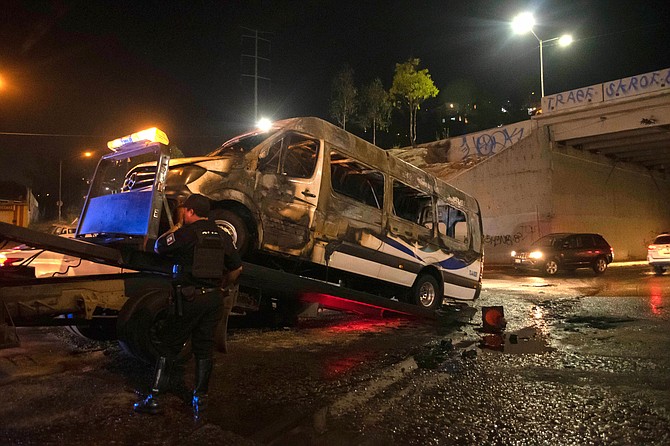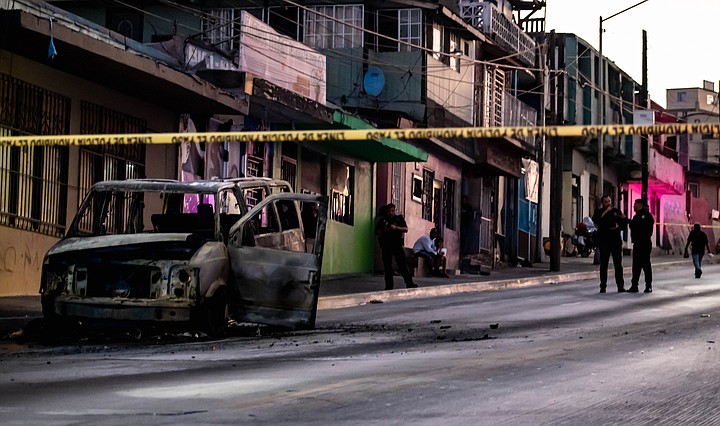 Facebook
Facebook
 X
X
 Instagram
Instagram
 TikTok
TikTok
 Youtube
Youtube

Last Friday, Tijuana’s citizens experienced something that has never happened before in the city. Cartel violence has become normalized in the last few decades, but the town was in shock when armed groups burned at least five small buses and blocked two of the city's main roads, one in the east and the other in the west.
People did not realize what was happening. Esteban Morales (not his real name), driver of a burned bus, said he had picked up two passengers on Agua Caliente Boulevard, one of the busiest streets in town. They were carrying a gallon of what appeared to be a cleansing product.

“They asked for their stop, and as soon as they got out, they started yelling: “All of you! Get out!” Some of the passengers asked why, and then they took out their pistols. I was told to get out of the unit with a gun pointing at me. After that a car passed by and picked them up, I tried to use an extinguisher but was too late, everything was burning.”
Around the same time, between 6:30 and 7:00 pm, several columns of black smoke appeared in the city’s landscape. Nayeli Roldan, who was riding on a small bus from Playas de Tijuana to downtown, saw two burning buses. She was planning to hang out with friends that Friday evening.
“When I saw the first small bus burning I didn’t give it too much importance because I have seen this before, but after I saw the second I thought something was going on. It was not until I was with my friend that we all realized what was happening, At 8 pm I started getting messages asking me if I was safe. On the streets lines for getting a taxi were huge. There was no public transportation, and the Uber fees were up to 700 pesos, a price I had never seen before.”
Nayeli made it safe back home thanks to a friend who gave her a ride from her house but said that the fear stayed in the air through the whole weekend. “You could feel the panic on the streets; people didn’t know how to get back home, and some places didn’t open the next few days."
The events affected activities like the movies in Zona Rio. Juana Briseño said while watching a movie with her family the projection was stopped and theater evacuated. “We saw one car arson in La Villa neighborhood; we thought was not a big deal, but in the theater, at the middle of the film we were evacuated. On our way back we saw some more, but the fire was almost out. I think they wanted it all to be seen; they did it in strategic places to cause fear.”
At the end of the weekend, 14 vehicles were burned in five of the six municipalities of Baja California. After the recounting of the damages, Tijuana’s mayor and the state’s governor sent out a video which claimed 17 people were involved in the events. The video demanded that the cartels keep citizens to the side in these unprecedented tactics of terror.


Last Friday, Tijuana’s citizens experienced something that has never happened before in the city. Cartel violence has become normalized in the last few decades, but the town was in shock when armed groups burned at least five small buses and blocked two of the city's main roads, one in the east and the other in the west.
People did not realize what was happening. Esteban Morales (not his real name), driver of a burned bus, said he had picked up two passengers on Agua Caliente Boulevard, one of the busiest streets in town. They were carrying a gallon of what appeared to be a cleansing product.

“They asked for their stop, and as soon as they got out, they started yelling: “All of you! Get out!” Some of the passengers asked why, and then they took out their pistols. I was told to get out of the unit with a gun pointing at me. After that a car passed by and picked them up, I tried to use an extinguisher but was too late, everything was burning.”
Around the same time, between 6:30 and 7:00 pm, several columns of black smoke appeared in the city’s landscape. Nayeli Roldan, who was riding on a small bus from Playas de Tijuana to downtown, saw two burning buses. She was planning to hang out with friends that Friday evening.
“When I saw the first small bus burning I didn’t give it too much importance because I have seen this before, but after I saw the second I thought something was going on. It was not until I was with my friend that we all realized what was happening, At 8 pm I started getting messages asking me if I was safe. On the streets lines for getting a taxi were huge. There was no public transportation, and the Uber fees were up to 700 pesos, a price I had never seen before.”
Nayeli made it safe back home thanks to a friend who gave her a ride from her house but said that the fear stayed in the air through the whole weekend. “You could feel the panic on the streets; people didn’t know how to get back home, and some places didn’t open the next few days."
The events affected activities like the movies in Zona Rio. Juana Briseño said while watching a movie with her family the projection was stopped and theater evacuated. “We saw one car arson in La Villa neighborhood; we thought was not a big deal, but in the theater, at the middle of the film we were evacuated. On our way back we saw some more, but the fire was almost out. I think they wanted it all to be seen; they did it in strategic places to cause fear.”
At the end of the weekend, 14 vehicles were burned in five of the six municipalities of Baja California. After the recounting of the damages, Tijuana’s mayor and the state’s governor sent out a video which claimed 17 people were involved in the events. The video demanded that the cartels keep citizens to the side in these unprecedented tactics of terror.
Comments